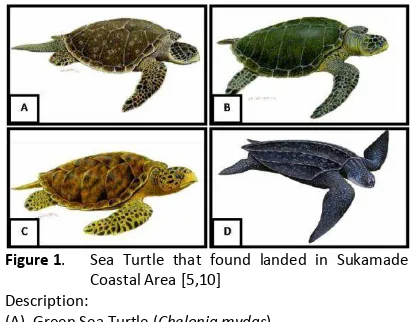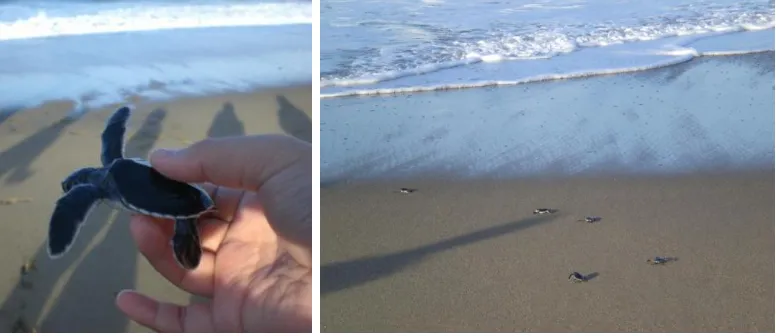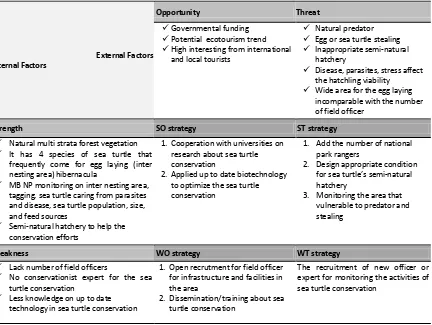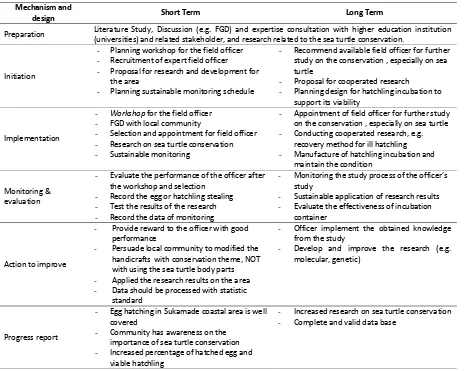J.Ind. Tour. Dev. Std., Vol.4, No.2, April, 2016
[67]
Action Plan in Developing Sea Turtle Conservation as Ecotourism Attraction in
Sukamade, Meru Betiri National Park
Jehan Ramdani Haryati
1*, Jayarani Fatimah Putri
2, Nurul Chairiyah
3, Ali Harris
4,
Helen Aulia Putri
5, Ratih Nila Pamungkas
51
Graduate School of Environmental Sciences, University of Brawijaya, Malang, Indonesia
2
Graduate School of Life and Environmental Sciences, University of Tsukuba, Ibaraki, Japan
3
State Senior High School 10, Samarinda, Indonesia
4Faculty of Fishery, Mataram ’45 Universit
y, Mataram, Indonesia
5
Master Program of Biology, University of Brawijaya, Malang, Indonesia
Abstract
Sukamade Coastal Area located in Meru Betiri National Park has particular object as ecotourism attraction, i.e. Sea Turtle. On the other hand, national park management use the cross subsidy from ecotourism activities to promote the conservation action plans for the survival of sea turtle. This study was aimed to formulate action plans to develop the sea turtle conservation as ecotourism attraction in Sukamade Coastal Area. Field observation was conducted to evaluate the current activities of the sea turtle conservation and ecotourism activities in Sukamade. Semi-structured interview and secondary data collection was also conducted to support the formulation of the action plan. Data was analyzed by SWOT method to be developed into action plan. Results showed that the management of sea turtle conservation and ecotourism activities in Sukamade Coastal Area has been attempted to meet the conservation concept for sea turtle but also beneficial for the ecotourism implementation. However, we recommend a long term and short term action plan for the sustainability of the sea turtle conservation and ecotourism activities in Sukamade Coastal area. It includes the mangrove restoration, sea turtle feed development, mapping of sea turtle distribution and migration, the use of up to date biotechnology, workshop on conservation management, and the development of research facility in the area. Additional to the current policy on sea turtle conservation and ecotourism activities, the action plan that we recommended were expected to improve the sustainability management in Sukamade Coastal Area.
Keywords: Action Plan, conservation, ecotourism, Sea Turtle.
INTRODUCTION
Tourism has major contribution in the eco-nomic development in Indonesia. Ecotourism as advanced concept of tourism deploy the sustain-able tourism development which aimed to support efforts on environment conservation (nature and culture). Ecotourism also improve the community participation in its management implementation [1]. The ecotourism activities were attempted to direct economy motif to-wards the conservation of natural resources and create value added for community. It concerns the continuity of the natural resources as the tourism attraction and also considers the econo-mic necessity [2].
Sukamade Coastal Area located administra-tively in the Regency of Banyuwangi, East Java and included in the area of Meru Betiri National Park (MB NP) [3]. Available tourism attractions
are beaches, fauna, and famously sea turtle’s egg
laying. Sukamade Coastal Area has become one
Correspondence address:
Jehan Ramdani Haryati
Email : [email protected]
Address : Jl. MT Haryono No. 169, 65145, Malang.
of conservation area for sea turtle in Indonesia [4]. Several sea turtle species commonly found laying their eggs in the coast. MB NP and local community keep trying to optimize the sea turtle conservation. However, many obstacles whether natural or managerial is lead to less performance for the sea turtle conservation activities, thus also affecting the ecotourism in Sukamade.
Sea turtle in that found in the world these days is consisted of seven species, which six of them considered as threatened with extinction by IUCN Red List of Threatened Species [5]. It means that four species of sea turtle that found in the area of Sukamade Coast are also threaten-ed by extinction. The species are green sea turtle (Chelonia mydas), grey sea turtle (Lepidochelys olivaceae), Hawksbill sea turtle (Eretmochelys imbricata), and leather back sea turtle (Dermochelys coriaceae). Major hazards that threaten the sea turtle are poaching to get sea
turtle’s meat and their eggs (consumptive recrea -tion/tourism). Thus, the most population of sea turtle was decreased.
eco-J.Ind. Tour. Dev. Std., Vol.4, No.2, April, 2016 [68]
tourism [6]; an alternative tourism that pre-serves the condition of nature. An example of this non-consumptive recreation was also developed in the efforts of sea turtle conservation in Sukamade. Meru Betiri National Park develops the sea turtle conservation as ecotourism attraction in Sukamade Coastal Area. The conservation activities towards the sea turtle, such as egg patrol, hatchery, and hatchling release are become the non consumptive uses for sea turtles [7]. Thus, the conservation activities of sea turtle itself become potential tourism attraction for Sukamade Coastal Area.
Therefore, this study was aimed to formulate action plans to develop the sea turtle conser-vation as ecotourism attraction in Sukamade Coastal Area. The output of this study is expected to improve the sustainability management for sea turle conservation and ecotourism activities in Sukamade Coastal Area. Pesanggaran, Regency of Banyuwangi and include in the management area of Meru Betiri Sea Turtle Conservation) which established in 2010. It is a special unit which formed to natural egg hatching, hatchling release, monitoring, the improvement of sea turtle habitat for the egg laying [8].
Acoording to the forest rangers and national park technician, there are 4 species of sea turtle that found in the area of Sukamade Coast (Fig. 1), i.e. green sea turtle (Chelonia mydas), grey sea turtle (Lepidochelys olivaceae), Hawksbill sea turtle (Eretmochelys imbricata), and leather back sea turtle (Dermochelys coriaceae). The most frequent sea turtle that landed in the Sukamade coastal area is green sea turtle (Chelonia mydas) with total landing percentage 96%. Green sea turtle in coastal area of Sukamade lay their egg 5 times in a season, with 2-3 years interval [9].
Figure 1. Sea Turtle that found landed in Sukamade Coastal Area [5,10]
Description:
(A). Green Sea Turtle (Chelonia mydas),
(B). Slengkrah/Grey Sea Turtle (Lepidochelys olivaceae), (C). Hawksbill Sea turtle (Eretmochelys imbricata), (D). Leatherback sea turtle (Dermochelys coriaceae)
Data Collection and Analysis
Field observation was conducted to evaluate the current activities of the sea turtle con-servation and ecotourism activities in Sukamade. Semi-structured interview was performed to obtain primary data on ecotourism activities related to sea turtle conservation in Sukamade (e.g. egg patrol, egg hatchery, hatchling release). Secondary data collection was also conducted to support the formulation of the action plan. Data was analyzed by SWOT (Strength, Weakness, Opportunity, and Threat) method to be developed into action plan.
RESULT AND DISCUSSION
Potential Tourism Attraction and Progress
The activities of sea turtle conservation that primarily offered to the tourist are patrol on sea
turtle’s egg laying, observation on the semi -natural hatchery, and hatchling release. Sea turtle commonly lay their eggs in the sand of Sukamade Coast at 6 pm to 6 am. A sea turtle will lay their egg 3-4 times in a season, with interval 14-30 days and 2-4 years seasonal interval. Sea turtle will initially observe the coast area from the surface of the sea, to determine the safety of the area for their eggs, from tidal wave or predators. After convinced with the area safety, sea turtle land and dig a body size hole in the sand with the hind flippers and a hole to lay the eggs with the back flippers. After the eggs lied, sea turtle will cover the hole and camouflage it before turning to the sea (Fig. 2). The times for this egg laying are about 2.5 hours [9].
The hatchery for the sea turtle’s egg is semi
J.Ind. Tour. Dev. Std., Vol.4, No.2, April, 2016
[69]
turtle in Sukamade Resort is in a building with size ± 4 x 8 m with substrate of coast sand (Fig. 3). Semi-natural hatchery was implemented to reduce the risk of hatching failure in its natural hatchery and prevent the predatory by wild pig, rats, lizard, etc. The eggs were obtained from the natural hatchery in the coast. The eggs will hatch in about 2 months. Each hatchery holes was marked by information board about the species, date of eggs taken, and the number of eggs. Succeeded hatched eggs and the mortality was recorded. The management also maintains the cleanliness of the hatchery. After hatched, hatchling should be incubated for 7-20 days before released (Fig. 4). Only 1% of hatchling will grow and develop into adult sea turtle [6]. The hatchlings was taken care in small tub with diameter ± 30 – 50 cm. Several hatchlings died
from fungal or bacterial infection, ants’
predation, and stress from water maintenance, density, temperature, or it secretes.
Figure 2. Lepidochelys olivaceae land to lay the eggs in Sukamade Coastal Area (Personal documenta-tion)
Figure 3. Semi-natural hatchery of sea turtle’s eggs in Sukamade Resort (Personal documentation)
J.Ind. Tour. Dev. Std., Vol.4, No.2, April, 2016 [70]
Problems of Sea Turtle Conservation in Sukama-de Resort
Many obstacles whether natural or mana-gerial are lead to less performance for the sea turtle conservation activities, thus also affecting the ecotourism in Sukamade. Natural or environ-mental causes include the parasites and disease in sea turtle (Fig. 5), anthropogenic disturbances in the visitation (Fig. 6), and continuous
irrespon-sible acts such as sea turtle’s meat and/or egg consumption and handicrafts from sea turtle’s
body parts.
Figure 5. Parasites and disease in sea turtle [10] Description:
(A). Teritip parasites (Barnacle, Sacculina, etc.)
(B). Tumor in sea turtle’s body (C). Moss or algae covered sea turtle (D). Abnormal hatchlings
Figure 6. Cautions to anthropogenic disturbance during visitation (personal documentation)
Otherwise, the managerial problems are including following items. Sea turtle’s egg
stealing becomes the most found problem in the process of managing sea turtle conservation in Sukamade. The thieves conduct its crime espe-cially at night, inadvertence of egg collector field officer. The management was also lack of field officer to collect the eggs and move it to the safe hatchery site. Egg hatching in the coast area has major predatory threat and thieves. Currently,
the field officer on the area was 6 personal, while the area of Sukamade Resort ranges for 10,000 ha has to be monitored and 2-3 person patrol in shift at night during the eggs laying seasons for 3 km ranges. Thus, the tourists that participate in the patrol help the officer a lot in collecting and transport the eggs. The process from the sea turtle gets to the seashore to laying their eggs is about 2 hours. The patrol officer competes with the natural predator such as wild pig and Manis javanica in getting the eggs.
Wide monitoring area in the coast of Sukamade extends about 3 km in length, with point of eggs laying changes. It becomes particular problem in collecting and found the eggs to be moved to the semi-natural hatchery site. Predator that consume or damage the eggs of sea turtle that commonly found in Sukamade Coast Area are rats, wild pig, Manis javanica, and Biawak (Varanidae). Although the field officer has already being caution, sometimes the predator gets to consume the eggs.
Hatching ability of the sea turtle’s egg is
fluctuating. Previous study mentioned that in April 2007, the hatching ability reached 87.5% while on March it only reached 77.1% [11]. This hatching ability has been ideal for the sustainability of sea turtle. Real condition of ideal hatching ability is up to 100%. The lower hatching ability of sea turtle eggs in Sukamade resort was assumed due to the process of collection, transportation to semi-natural hatchery, and hatching process itself.
Hatchling viability also problem faced after the hatching. Hatchling of sea turtle was taken care for one week and or for longer period for further caring procedure. Container for these hatchlings are small tubs with diameter ±30– 50cm. several hatchling dead due to fungal disease in their eyes area, ants’ attack, and stress from water replacement, density, temperature or pollution from their own excretion. Some death did not show any changes in their morphology.
J.Ind. Tour. Dev. Std., Vol.4, No.2, April, 2016
[71] Monitoring on Sea Turtle Conservation
Monitoring activities on the sea turtle conservation includes the activity of egg laying, tagging, parasites removal and body measure-ment. The aims of the monitoring are to ensure the sea turtle existence refer to the attached tag and attaching the tag to the sea turtle which has no tag, examine the health of the sea turtle by removing the parasites, observing the egg laying process and save the eggs to the hatchery. From this monitoring, we obtained the data base on the number of eggs from each sea turtle, sea turtle distribution, egg laying frequency, and egg laying behavior of sea turtle. Monitoring was conducted regularly every night by the patrol officer.
SWOT Analysis
Strength, weakness, opportunity, and threat of the sea turtle hatchery conservation manage-ment were used to arrange the SWOT matrix (Table 1). Analysis of SWOT was used to deter-mine strategy and formulate the action plan for development of sea turtle conservation efforts along with a better ecotourism destina-tion.
Recommended Action Plan
From the SWOT analysis, we obtain several root cause in the sea turtle conservation program in Sukamade. The root causes are natural predator and egg and/or hatchling stealing, pathogenic microbes which lead to decrease hatchling viability, and lack number of officer and experts in sea turtle conservation. Regarding this, thus we aimed to optimize the conservation efforts in MB NP. The action plan was expected to give outputs on optimum performance for sea turtle conservation to support the ecotourism in Sukamade.
Inputs for the action plan are all hatched sea turtle in Sukamade Coastal Area would be well covered, high percentage of egg hatching and hatchling viability, and field officer and competent expert on sea turtle conservation. Whereas the expected outcomes are efficient natural, human, and funding resources; qualified sea turtle hatchling to survive their life; and create habitat for egg hatchery with better and more stable environment condition.
Table 1. SWOT analysis on the sea turtle conservation in Sukamade Resort
External Factors Internal Factors
Opportunity Threat
Governmental funding Potential ecotourism trend High interesting from international
and local tourists
Natural predator Egg or sea turtle stealing Inappropriate semi-natural
hatchery
Disease, parasites, stress affect the hatchling viability Wide area for the egg laying
incomparable with the number of field officer
Strength SO strategy ST strategy
Natural multi strata forest vegetation It has 4 species of sea turtle that
frequently come for egg laying (inter nesting area) hibernacula
MB NP monitoring on inter nesting area, tagging, sea turtle caring from parasites and disease, sea turtle population, size, and feed sources
Semi-natural hatchery to help the conservation efforts
1. Cooperation with universities on research about sea turtle conservation
2. Applied up to date biotechnology to optimize the sea turtle conservation
1. Add the number of national park rangers
2. Design appropriate condition
for sea turtle’s semi-natural hatchery
3. Monitoring the area that vulnerable to predator and stealing
Weakness WO strategy WT strategy
Lack number of field officers
No conservationist expert for the sea turtle conservation
Less knowledge on up to date technology in sea turtle conservation
1. Open recrutment for field officer for infrastructure and facilities in the area
2. Dissemination/training about sea turtle conservation
J.Ind. Tour. Dev. Std., Vol.4, No.2, April, 2016 [72]
Action plan that we promoted for the conservation of sea turtle in Sukamade is consisted a long term and short term program. It includes the mangrove restoration, sea turtle feed development, mapping of sea turtle distribution and migration, the use of up to date biotechnology, workshop on conservation management, and the development of research facility in the area. The mechanism and design of the action plan described in following Table 2. Resources required to implement the action plan are Dept. of Culture and Tourism Banyuwangi, officers in the sea turtle hatchery of MB NP, higher education institution, research center of sea invertebrate, the area of MB NP and sea turtle hatchery, and references on the development of sea turtle hatchery and conservation along with ecotourism [12,13,14]. As for the performance indicator (Table 3), we compare the initial condition to the final condition that we expected from the action plan.
For the sustainability of the action plan, we also recommend several activities related to the sea turtle conservation. The seedling and planting of mangrove surround the coastal area of Sukamade should be done to provide habitat for sponges, bivalves, mollusk, shrimp, seaweed, and alga as the food for sea turtle. This feed diversity should be assessed for further decision making for the development of the sea turtle proposed to the regional and central government to develop the infrastructure of MB NP and research development about sea turtle in MB NP.
Table 2. Mechanism and Design of the Action Plan for the Sea Turtle Conservation Activities in Sukamade
Mechanism and
design Short Term Long Term
Preparation Literature Study, Discussion (e.g. FGD) and expertise consultation with higher education institution (universities) and related stakeholder, and research related to the sea turtle conservation.
Initiation
- Planning workshop for the field officer - Recruitment of expert field officer - Proposal for research and development for
the area
- Planning sustainable monitoring schedule
- Recommend available field officer for further
study on the conservation , especially on sea turtle
- Proposal for cooperated research - Planning design for hatchling incubation to
support its viability
Implementation
- Workshop for the field officer - FGD with local community
- Selection and appointment for field officer - Research on sea turtle conservation - Sustainable monitoring
- Appointment of field officer for further study
on the conservation , especially on sea turtle
- Conducting cooperated research, e.g.
recovery method for ill hatchling
- Manufacture of hatchling incubation and
maintain the condition
Monitoring & evaluation
- Evaluate the performance of the officer after
the workshop and selection
- Record the egg or hatchling stealing - Test the results of the research - Record the data of monitoring
- Monitoring the study process of the officer’s
study
- Sustainable application of research results - Evaluate the effectiveness of incubation
container
Action to improve
- Provide reward to the officer with good
performance
- Persuade local community to modified the
handicrafts with conservation theme, NOT with using the sea turtle body parts
- Applied the research results on the area - Data should be processed with statistic
standard
- Officer implement the obtained knowledge
from the study
- Develop and improve the research (e.g.
molecular, genetic)
Progress report
- Egg hatching in Sukamade coastal area is well
covered
- Community has awareness on the
importance of sea turtle conservation
- Increased percentage of hatched egg and
viable hatchling
J.Ind. Tour. Dev. Std., Vol.4, No.2, April, 2016
[73] Table 3. Performance Indicators of the Action Plan for the Sea Turtle Conservation Activities in Sukamade
Orientation of the
action plan Before After
Short Term
- Patrol officer 2-3 persons with irregular shift - No expert officer for sea turtle conservation - Percentage of hatched egg 70%
- Hatchling monthly mortality 25% - No efforts in handling the ill hatchling - Many eggs and hatchling were stolen
- Patrol officer 6-7 persons with regular shift - expert officer for sea turtle conservation
available
- Percentage of hatched egg 90% - Hatchling monthly mortality < 5%. - Innovation to handle the ill hatchling - Less (and/or none) stolen eggs or hatchling
Long Term
- Officer has not applied biotechnology for the
conservation efforts
- Officer only take care the hatchling - Level of Sanitation quality 50%. - No specific vaccine/medicine for the ill
hatchling
- Officer applied the biotechnology for the
conservation efforts
- Officer also able to formulate action plan on
existing problems
- Level of sanitation quality 100% - Specific vaccine/medicine for ill hatchling
The results of the research on sea turtle conservation also need national and international dissemination to be recognized by the world, thus increase the awareness for sea turtle conservation and attract tourist to be involved in the conservation efforts as well as ecotourism in Sukamade coastal area.
CONCLUSION
Action Plan consisted of a long term and short term for the sustainability of the sea turtle conservation and ecotourism activities in Sukamade Coastal area. It includes the mangrove restoration, sea turtle feed development, mapping of sea turtle distribution and migration, the use of up to date biotechnology, workshop on conservation management, and development of research facility in the area. Additional to the current policy on sea turtle conservation and ecotourism activities, the action plan that we recommended were expected to improve the sustainability management in Sukamade Coastal Area.
REFERENCES
[1] Atmoko, W. D. 2008, Studi prospek peng-embangan ekowisata pada kawasan sekitar Kars Gombong Selatan dalam mendukung keberlanjutan wilayah. Thesis. Dipenegoro University. Semarang. eprints.undip.ac.id/ 4363/1/Wisnu_Dwi_Atmoko.pdf.
[2] Hedrick, L. W. 2008. Ecotourism sustainabi-lity. Available at: http://digitalscholarship. unlv.edu/thesesdissertation/483.
[3] Diantoro, W. 2008. Pantai Sukamade. Available at: http://www.wisatanesia.com /2010/05/pantai-sukamade.html.
[4] Nusantara. 2011. Pantai Sukamade.
Available at: http://nusantara.asia/jawa /jawatimur/pantai-sukamade/.
[5] IUCN. 2012. IUCN SSC marine turtle specialist group: about Marine turtles. Inter-national Union for Conservation of Nature. Available at: https://iucn-mtsg.org/about-turtles/.
[6] Wilson, C. and C. Tisdell. 2001. Sea turtles as a non-consumptive tourism resource es-pecially in Australia. Tourism Management 22, 279-288.
[7] Hakim, L and N. Nakagoshi. 2006. Sea Turtles and its non consumptive uses in East Java. 3rd Coastal Zone Asia Pacific Confe-rence, August, 29 – September 2, Batam, Indonesia.
[8] Meru Betiri National Park. 2012. Informa-tion on Meru Betiri NaInforma-tional Park. Office of Meru Betiri National Park. Banyuwangi. [9] Officer of Sukamade Resort. 2012. Sea turtle
Conservation. Personal communication. Office of Meru Betiri National Park.
[10] Dermawan, A., I.N.S. Nuitja, D. Soedharma, M.H. Halim, M.D. Kusrini, S.B. Lubis, R. Alhanif, M. Khazali, M. Murdiah, P.L. Wahjuhardini, Setiabudiningsih, A. Mashar. 2009. Pedoman teknis pengelolaan konser-vasi penyu. Directorate of Conservation and Sea National Park, Directorate General of Marines, Coastal and Small Islands, Department of Marine and Fisheries, Republic of Indonesia. Jakarta. 19-68. [11] Prihanta, W. 2007. Problematika kegiatan
J.Ind. Tour. Dev. Std., Vol.4, No.2, April, 2016 [74]
[12] James, M. C., Ottensmeyer C. A. and Myers R. A. 2005. Identification of high-use habitat and threats to Leatherback Sea Turtles in Northern Waters: new directions for conserva-tion. Ecololy Letter 8, 195–201. [13] Tisdell, C. and C. Wilson. 2000. Developing
of Ecotourism for the survival of Sea Tur-tles. Working Papers on Economics, Ecology, and the Environment, No. 45. University of Queensland. Australia.


![Figure 5. Parasites and disease in sea turtle [10] Description: (A). Teritip parasites (Barnacle, (B)](https://thumb-ap.123doks.com/thumbv2/123dok/2887842.1697488/4.595.91.282.424.595/figure-parasites-disease-turtle-description-teritip-parasites-barnacle.webp)


